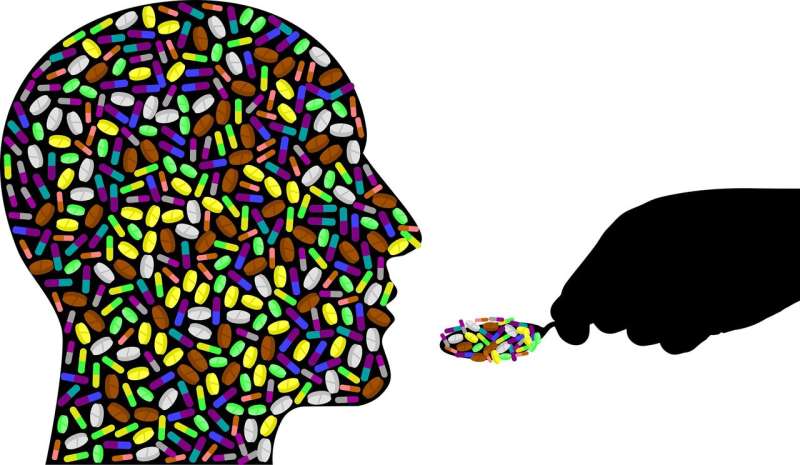This article has been reviewed according to Science X's editorial process and policies. Editors have highlighted the following attributes while ensuring the content's credibility:
fact-checked
trusted source
proofread
The next generation of the opioid epidemic: Youth polysubstance users

It's a new year, and once again, the opioid epidemic continues to hold a tight grasp on millions of Americans. At the end of last year, the United States reached a major milestone of over one million overdose deaths since the year 2000. And while public health efforts to combat this epidemic have been largely focused on adult opioid use, there is a population of substance users that are commonly overlooked: youth stimulant users.
Substance use habits are often initiated during adolescence and young adulthood, but interventions and clinical information targeting this main source contributing to opioid overdose rates remain few and far between. Those who initiate use at a younger age are also more likely to develop use disorders and less likely to seek treatment as well.
Not only does this population lay the groundwork for the continuation of the opioid epidemic, but a new problem is arising with youth substance users, in which they are not just using opioids, but also stimulants at the same time.
"Our national conversation has focused on opioid use (especially fentanyl use) as the leading cause of fatal overdoses in the US, but our team has shown that, since 2017, it is now more common for adolescents and young adults to overdose on an opioid in addition to another substance," says Scott Hadland, MD, MPH, MS, a clinician-researcher and Chief of the Division of Adolescent and Young Adult Medicine at Mass General for Children.
Hadland is the co-author of a recent article in Current Problems in Pediatric and Adolescent Health Care, titled Stimulant Misuse Among Youth along with Natalie J. LaBossier, a medical student at the Boston University School of Medicine.
According to their article, there has been a 48% increase in overdose deaths among those aged 15-24 from 2019 to 2020. While the majority of these overdoses are due to opioids, there are a growing number of individuals who are using multiple substances such as methamphetamine and cocaine along with opioids—something that Hadland has seen firsthand in his clinical practice.
"Our clinic cares for adolescents and young adults with substance use disorders, and I have observed a rising number of young people in my practice struggling with stimulant use disorders involving cocaine, methamphetamine, and/or prescription stimulant pills like Adderall," says Hadland. "Many of us are observing that among youth who have a substance use problem, those problems are intensifying."
Polysubstance use is common among youth users and can include substances such as cocaine, methamphetamine, and the nonmedical use of prescription medications like Adderall and Xanax.
Students who use stimulants not prescribed to them actually report much poorer academic performance, and in 2020, almost one in ten high school seniors reported misusing prescription methamphetamines, and college-age young adults had even higher rates.
More than half of youth opioid overdose deaths in 2018 involved another substance in addition to the opioid, and one-third involved stimulants, with cocaine being the most common. Illegal stimulants can commonly lead to psychosis, emotional disturbances, and an increased risk of injection-related infections such as HIV and Hepatitis C.
But how do we solve this problem before it creates another generation of opioid epidemic victims? Many people look to their child's pediatrician or another medical professional for help, but these professionals more than likely did not have the opportunity to study this topic in medical school, and clinical information remains sparse. Hadland and his team are hoping to change that.
"Our clinic cares for adolescents and young adults with substance use disorders on a daily basis, but there's very little guidance on what pediatricians should do to address stimulant use disorders in young people, which led us to write this piece." Dr. Hadland states.
Currently, there are no FDA-approved medications for stimulant use disorder, and the evidence on behavioral interventions remains very limited. Further research is needed to understand how stimulant misuse develops, and to develop methods to treat the disorder.
"We wrote this for clinicians who work with young people. Our primary goal is to help our colleagues understand the extent of the problem—that stimulant use, stimulant use disorders, and stimulant-involved overdoses are all on the rise among America's youth—and support our colleagues in addressing these concerns in their own clinical practices."
So while educating medical professionals is not the only way to treat this issue, it's a great start to preventing the next generation from falling victim to the opioid epidemic.
More information: Natalie J. LaBossier et al, Stimulant misuse among youth, Current Problems in Pediatric and Adolescent Health Care (2022). DOI: 10.1016/j.cppeds.2022.101265



















